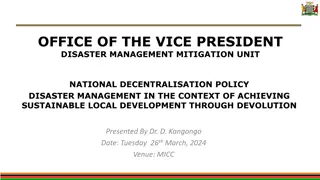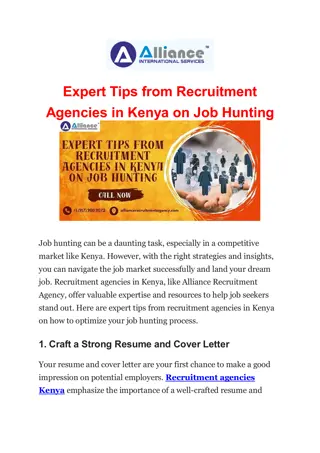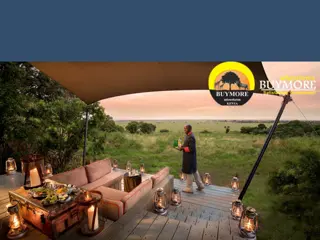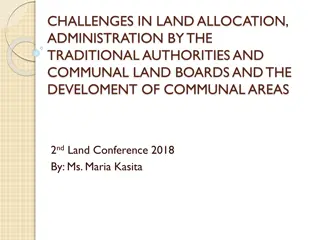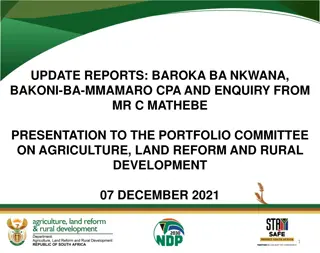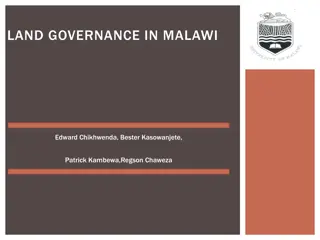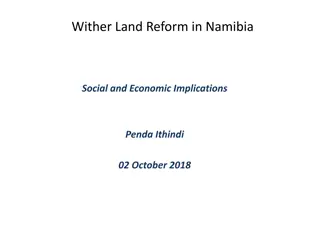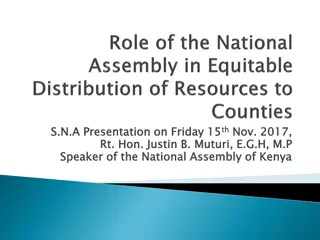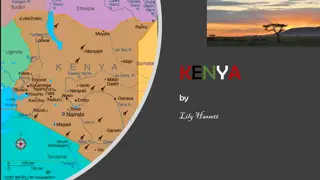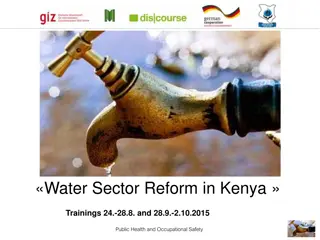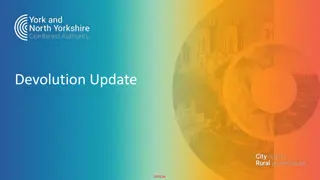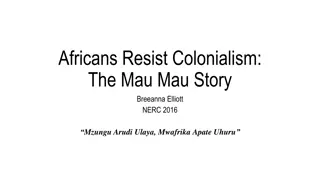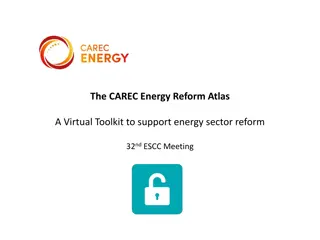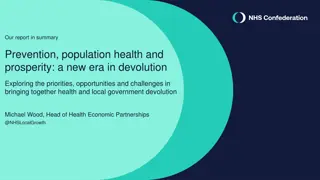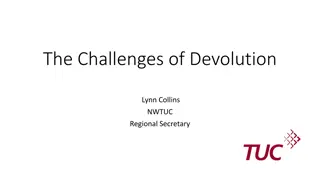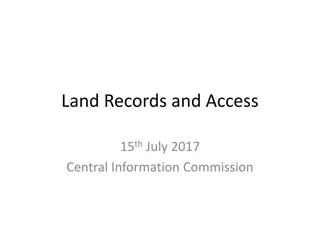Land Reform in the Context of Devolution in Kenya
Kenya, with a land area of 582,646 sq. Km, has undergone land reform in the context of devolution since gaining independence in 1963. The country's adoption of the Constitution in 2010 led to the establishment of a system with 1 national government and 47 devolved governments. Kajiado County, inhabited mainly by the Maasai pastoralist community, faces challenges such as encroachment on fragile land due to its proximity to Nairobi. Various reports and complaints have highlighted the need for land reform in this region. Rapid land sales by the Maasai have also been a significant issue in the past.
Download Presentation

Please find below an Image/Link to download the presentation.
The content on the website is provided AS IS for your information and personal use only. It may not be sold, licensed, or shared on other websites without obtaining consent from the author.If you encounter any issues during the download, it is possible that the publisher has removed the file from their server.
You are allowed to download the files provided on this website for personal or commercial use, subject to the condition that they are used lawfully. All files are the property of their respective owners.
The content on the website is provided AS IS for your information and personal use only. It may not be sold, licensed, or shared on other websites without obtaining consent from the author.
E N D
Presentation Transcript
LAND REFORM IN THE CONTEXT OF DEVOLUTION By Everlyne Komba, Ali Letura, Kenneth Odary
Background & Context Background & Context - -Kenya Kenya Kenya Kenya has an area of approximately 582,646 sq. Km; Independence gained in 1963; Land is mostly arid or semi-arid; Adopted Constitution of Kenya in 2010; new Agriculturally the country has been classified into three broad zones high, middle and low; 80% of the population is settled on only about 20%; System of government is with 1 national and 47 devolved governments; Unitary republic 70% of the land is held under customary systems of ownership and use; Devolved officially Counties Governors of County Executive and Legislators who sit Assembly. units called Economic activities in the high and medium potential agricultural and livestock husbandry; is characterized by intensive led in-charge by Economic activities in the low potential areas is pastoral, ranching and wildlife based systems and in some places, dry-land farming. in the County
Kajiado Background & Context Kajiado County Kajiado county has an area of approximately 21,292.7 km and population of 687,312; Majority Inhabited by the Maasai pastoralists community; Closely located to Nairobi City; Kajiado is mostly semi-arid; Proximity to Nairobi has led to encroachment on fragile Kajiado land.
Catalyst National Land policy 2009 CoK, 2010 chapters3,4,5,11, Various Land commission reports Numerous complaints regarding land by Kajiado residence Drivers County Government Governor, County Executive Committee (Cabinet) County Executive for (Minister) Lands, Physical planning and natural resources Civil Society Organizations Academia
Rapid Land Sales by the Maasai brought to the fore by Kituyi (1990) in BecomingKenyans Rutten (1992) Selling Wealth to Buy Poverty: The Process if Individualization of Land Ownership among the Maasai pastoralists of Kajiado District 1890-1990 . Also by Galaty (1994)- Rangelands and Tenure and Pastoralism in Africa .
Level None Primary Secondary College University Total % 43.8 26.7 15.3 10.3 3.9 100
Main occupation of household head Occupation % Businessmen/ woman 29.3 Formal employment 8.5 Casual labourer / unemployed 13.8 Pastoralism / livestock keeping 40.1 Crop farmer 0.7 Land broker 0.4 Self employed Total 7.2 100
Mode Bought % 6.1 Inherited from father 63.7 From group ranch 20.8 Allocated by government 7.5 Allocated by county council 0.8 Fenced it myself 1.8 Total 100
Land buyer % A company 3.7 Religious institutions 2.3 Educational institutions 0.5 A group of people 15.8 SACCO 2.3 An individual Maasai person 14.4 An individual non-Maasai person 50.7 An Asian 3.3 A land broker 5,6 A European 1.4
Why sell land % To pay school fees 47.3 To clear a debt 10.1 To invest in real estate 12.2 To purchase more livestock 36.5 A land broker convinced me 18.2 A buyer approached me 7.4 Leisure 4.7 In order to pay for land subdivision 1.4 Poverty 1.4 To build a new modern home 3.4 To use the money for initiation ceremony 2.0 To drill a borehole 1.4 To save money in the bank 1.4
Buy household goods e.g. sofaset, TV, bicycle 25.0 Drinking alcohol 23.6 Buy urban plot 21.6 Subdivide jointly owned land 18.2 Buy a car 17.6 Buy another land elsewhere 15.5 Buy new clothing 10.8 Build a house 9.5 Marry another wife / wives 6.8 Travel to new places 4.7 Paid school fees 4.7 Paid debt 2.0 To prepare initiation ceremony 0.7 Bought more livestock
61.0% involved a land broker in the land transaction, mostly a fellow Maasai but also chiefs, government officers, surveyors and religious leaders 47.3% received payment direct from the land buyer, 38.0% from the land broker and 14.7% from the lawyer 25.0% land owners received all payment at once 75.0% received it in installments
Payment in kind - car 17.4%, bank transfer 4.3%, mobile money 6.5% cheque 2.4%. 25.3% of Household heads were aware of another land seller who did not receive all his money.
Possibility of reaction Demand all their land is returned % 37.4 Demand part of their is returned 17.2 Wallow in poverty 14.5 Become squatters 10.4 Nothing 5.2 Children go to the streets 8.9 Conflict between buyer and seller arise 3.9 Ethnic conflict 1.1 Forceful land takeover 0.2
Numerous national and county policy directives contradictions; Land registries was not a devolved function; County Land Management Board mandate on public land not fully appreciated; Consent from kin absent in many cases; Land control board role in subdivisions glaring; Land use planning was individual based due to land use planning tools being routinely ignored.
Unpreparedness for urbanization characterized by shanty towns and Corridor type development along major arteries; Insufficient information on land suitability to ensure optimal use; Land use planning function is not well resourced/capacitated; Land use planning approaches very restrictive, not facilitative enough.
Land sales not helping ordinary Maasai; Unnecessary /unprofessional conduct including proliferation of land brokers, both formal and informal; multiplicity of actors and unethical Succession/Inheritance fueling land sales.
Shrinking land carrying capacity eroding beef production; Depletion and pollution of water sources; Increased causing conflicts; fencing undermining wildlife and Increased migration from rural to urban by Maasai characterized by increased vulnerability of Women and youth left landless.
The County government needs to develop a domesticated land policy to guide land transaction and land use; Engage the professional bodies on omission and commission of their members- explore formulation Kajiado specific rules of engagement to fight corruption and illegal transactions in the national and county land offices; Establish Local/Community committees comprising of men, women and youth to vet and approve individual land sales applications before official transactions commence; Sensitization and awareness creation of the community by county leaders on land sales, registration of deaths and law of succession/inheritance among others.
Undertake a study on land banking using public private and community partnerships (PPCP) through which the County Government can purchase land and hold on behalf of the community; Land Owners be encouraged and facilitated to form a land cooperative which will hold all the land; Ensure all land actors carrying out land transactions in Kajiado are regulated.
Empowerment alternative livelihoods away from sale of land and livestock; of the Maasai community Need for increased awareness creation and education among the Maasai through the County department for Social Services and gender; Diversify sources of income for households since a considerable proportion of land sellers cite fees payment as the main reason for land sales.
County Government organized the Kajiado County Consultative Forum; The forum included stakeholders drawn from across the county including youth and women groups, civil society, interested investors, private organizations, natural resource groups engaged in sand harvesting and charcoal burning, county legislators and County executives; Deliberated and validated the findings of the baseline survey; Set the stage for the selection of an all inclusive policy team
Arising from the consultations; A draft policy was deemed necessary to be formulated to reach the desired threshold; A team to guide the policy process were nominated and meeting dates arranged; The team was tasked to ensure document promotes efficient engagement on land by all actors at all levels.
P Policy process methodology Brainstorming document olicy process methodology ; ; Brainstorming document visioning process, problem tree analysis; on on Issues Issues and and f format ormat of of p policy olicy Syndicate part of the policy document, situation analysis, institutional framework and the policy implementation matrix; Syndicate group group sessions sessions generated generated introductory Plenary from the rest from participants; Plenary discussions discussions - - to discuss and receive input Drafting into policy language and populating the policy themes. Drafting of of policy policy document document streamlining statements
Clustered done at venues proximate to stakeholder groups; Clustered meetings meetings with with different different stakeholders stakeholders groups groups Consensus document was harmonized reflecting the different inputs by stakeholder groups; Consensus building building on on draft draft policy policy document document Policy Presentation policy was presented to the County Executive for Land who then presented to the county cabinet for approval; Presentation and and Approval Approval of of draft draft policy policy- - the finalized draft Transmission requirements the County Executive transmitted the policy to the County Assembly through the Sectoral committee on Lands, Physical planning, Housing and Natural Resources. Transmission to to legislative legislative assembly assembly Pursuant to the legal
Policy now seeks to enhance joint land ownership thus bringing constitutional intentions closer; Policy now calls for the establishment of mechanisms to enable families retain minimum percentage of acreage thereby assuring availability of land to future generations; Policy now calls for the establishment of a framework to regulate artisanal mining of sand and other natural resources which are youth; Policy now call for creation of organized livelihood opportunities for youth such as those engaged in land broking; Policy now tasks the County government with ensuring further public education on land rights especially those relating to Law of succession, Matrimonial property act and Children s act; Further, the policy now tasks the county government participation marginalized groups in decision making organs. Policy now seeks to promote formation of both housing and land cooperatives in which women are properly represented; Policy involvement management; now seeks of to deepen in the land women Policy now seeks to encourage women to lodge complaints and seek reprieve against the sale of land without spousal consent; Policy governance through establishment of consultative citizen fora with significant representation of women. now seeks to strengthen with of ensuring vulnerable greater and Women Youth
Publishing presented in the county assembly; Publishing and and tabling tabling the draft was published and Scrutiny Orders, the policy document was introduced in the House, by the relevant House Committee for scrutiny and further consideration. Further, like all State entities, subject to the mandatory constitutional principle of public participation, the House may subject the policy to public and stakeholder consideration; Scrutiny and and consideration consideration - in accordance with the Standing Report to the whole House which approved the policy document with minor amendments; Report back back and and Amendments Amendments- - The Committee reported back Assent Speaker submitted the approved policy to the Governor to formally endorse, by affixing the County Seal and signing the policy. Assent and and publication publication- - Upon passing of the policy the the
To widely circulate the policy as well as keep the public informed of the likely effects of the Policy the County Executive organized a launch ceremony to raise the profile of the Kajiado land policy necessary for its implementation. In particular the launc workshop aimed to: including generating political will Provide an overview of the Kajiado land policy roadmap and the interface with relevant national agencies; Present an overview of the background research on land in Kajiado; Raise awareness of the land issues in Kajiado county Increase the awareness on the role of Kajiado land policy and the perspectives for the implementation.
Evidence based policy making can embrace a plurality of stakeholders; Government is the best placed actor to setup mechanisms for public participation in delivering public goods and services; Understand the levels of vulnerability and marginalization; Work through legitimate mechanisms and ongoing processes to get public buy-in.
Political will and teamwork by the those in Government ensured confidence in the process; Popular Participation and Multi-stakeholder engagement helped to negotiate competing interests and create ownership of the process; Inclusivity and dialogue created spaces for mainstreaming of issues of the marginalized leading to gender transformation; Work through legitimate mechanisms and ongoing processes to galvanize public buy-in; Understand context specific issues in order to better explain pertinent land matters to members of the public.
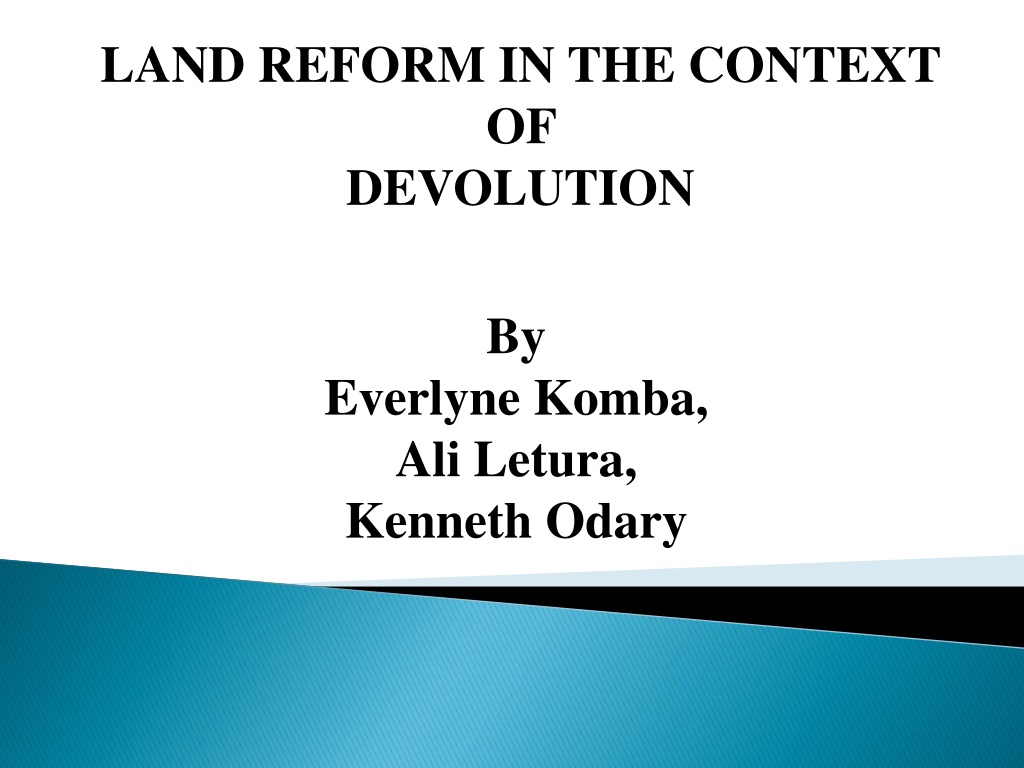
 undefined
undefined
 undefined
undefined



